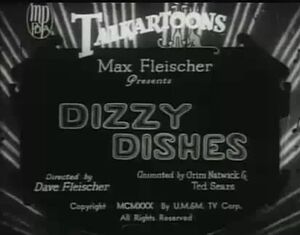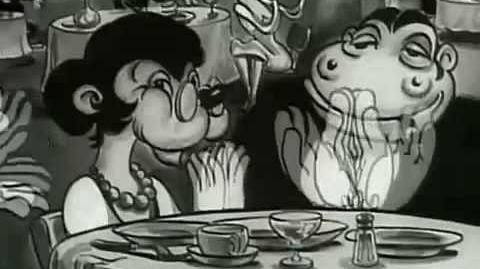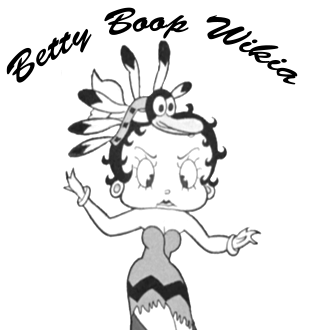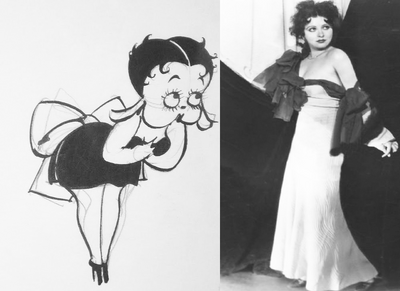| Dizzy Dishes | |
|---|---|
 | |
|
Name |
Dizzy Dishes |
 | |
|
Name |
Dizzy Dishes (1930) |
Dizzy Dishes is a 1930 cartoon about out-of-work actors who work at a nightclub. The short film begins with a chorus of singing flapper cats. Bimbo waits on a hungry gorilla and then goes to the kitchen to prepare the order, roast duck. When he is about to bring it to the gorilla's table, he sees an anthropomorphic French poodle-esque caricature of Helen Kane (dubbed "The Original Boop-Oop-a-Doop-Girl") performing a "Boop Boop a Doop" song onstage, and falls in love at first sight. He completely forgets about his hungry customer and dances onstage with the duck. The gorilla gets furious and begins to chase after Bimbo, who escapes on a wooden train.
Quotes
- Bimbo: "Roast Duck!"
- Bimbo: "Poop-Oop-a-Doop-Poo!"
- Betty Boop: "I have to have Poopa-Doopa-Doopa-Doo-Poop-Oop-a-Doop! Whoopee!"
- Gus Gorilla: "Where's my roast duck?"
Characters
Cast & Crew
- Margie Hines as Betty Boop/Cats
- Billy Murray as Bimbo
- William Billy Costello as Gus Gorilla
- Max Fleischer (Producer)
- Dave Fleischer (Director)
- Grim Natwick (Animator)
Grim Natwick on Betty Boop's Creation
Grim Natwick:
"In 1930 I created Betty Boop. By brief history is that - uh - I don’t know if you’re interested. I worked for so many studios. I started with a dog with long graceful ears and a cute little collar, but I thought a dog can't sing this song."
One day, Dave Fleischer handed Grim Natwick a photograph of singer Helen Kane and asked him to design a caricature. Fleischer had found a sound-alike, and planned to use her in the upcoming Talkartoon, Dizzy Dishes. Grim exaggerated Kane’s wide eyes and rosebud mouth, creating a slightly coarse, but strikingly original design. A few weeks later, Dave Fleischer asked Natwick to design a girlfriend for Bimbo to star as the "fair young maiden" in a cartoon adaptation of the popular song "Barnacle Bill The Sailor". Natwick streamlined and refined his caricature of Kane for the part, but Dave Fleischer objected, insisting that since Bimbo was a dog, his girlfriend should also be a dog. Natwick quickly sketched Betty Boop’s head on a four-legged canine body. He held up the drawing next to the pretty girl design, and asked, 'Which would you rather have as your girlfriend? A girl? Or a dog?' Fleischer laughed and agreed that the pretty girl was the right choice
Margie Hines the Original Voice of Betty Boop
At the age of 17 Marjorie Louise Hines won first place in a local Helen Kane impersonation content sponsored by Paramount Pictures, which was held in Brooklyn. According to Helen Kane, Hines had actually entered three Helen Kane impersonation contests and was best known for her Helen Kane impersonation. Hines went on tour and was seen performing by Billy Murray, who found what the Fleischer Studios were seeking in Betty Boop. Margie Hines was the original voice of Betty Boop and portrayed the character in Dizzy Dishes and Barnacle Bill in 1930. Hines continued to do the role which was shared with Little Ann Little, until some career opportunities came her way. The role of the character was later taken over by Mae Questel in 1931, and was shared with several other women, most of which who entered Helen Kane contests. Hines continued to portray Betty on radio, sharing the role with Questel and Bonnie Poe, and returned to voice the character in 1938, going on to finish the original series as Betty Boop in 1939. Before Hines entered the entertainment field, she was employed as an office worker in New York. When Grim Natwick later recalled the story of Betty Boop in Dizzy Dishes, he thought that Helen Kane had done the role, whereas in earlier interviews, he'd stated that the voice was provided by an impersonator.
Betty's Origin
The as-yet-unevolved Betty Boop is drawn as an anthropomorphic dog. Except for the ears, she resembles a human girl in her latest incarnation. Also, she is merely a side character; the plot of the story revolves around the incompetent chef Bimbo and the irate gorilla-customer. The character that debuted in Dizzy Dishes was such a massive hit that Fleischer Studios decided to use her again. Dave Fleischer had regarded Betty as being very ugly in her first appearance, so they gradually re-designed her. From the 1930 short Mysterious Mose, Betty had became silmmer and, by 1931, she had lost the snout. From 1932 onwards, she became a fully human character. Grim Natwick created Betty Boop after he was handed a photograph of 1920s singer and actress Helen Kane, and had used Kane as the basis for Betty; Kane later launched a lawsuit over this, only to lose because she failed to prove her claims as her singing style was quite common in the early 20s-30s, plus every flapper girl (most prominently Clara Bow, the "It Girl") had similar hairstyles to Kane. It was later discovered that Kane had taken the scat lyrics from a little-known African-American child performer from Chicago by the name of Baby Esther. Other claims were that a witness had heard the phrase uttered in an Edith Griffith song, and another defense asked Kane if she had heard a 1913 song called "Bou Dou Ba Da Boum", which she denied.
Music
- "I Have To Have You"
- "Crazy Jingle"
- "Abaloney"
- "Hot-Cha-Cha"
- "Never Say Die"
Gallery
Trivia
- Was released on the 9th of August in 1930.
- Betty Boop performs Helen Kane's hit song "I Have to Have You", from the 1929 film Pointed Heels. whilst performing on top of a table.
- The character uses a variety of Boops and Poops in song, as "Boop-Oop-a-Doop" was not officially used until 1932, and the fact that "Boop-Boop-a-Doop" was actually "Poop-Poop-a-Doop" and also "Poo Poo Padoo".
- Gus the Gorilla, another character from the Betty Boop series, also appears at the cabaret where he is seen trying to order a roast duck from Bimbo.
- The cartoon starts off with a group of flapper cats dancing to the crazy jingle theme.
- At the age of 17, Margie Hines was hired for this one-shot to record the cover of a song previously sung by Helen Kane.
- The public's reaction was so great that Paramount urged Fleischer to continue developing this cartoon caricature of Helen Kane, changing the character through each and every appearance, making the character more appealing to the public. As the character was originally fat and ugly, according to the creators. After Dizzy Dishes, Betty was more slender, and had an hourglass figure.
- This animated short is considered the first Betty Boop cartoon from the Talkartoon series.
- Helen Kane was originally flattered when she saw a Betty Boop cartoon for the first time, but later got upset when the character became a hit sensation, so Helen claimed plagiarism.
- Betty Boop had become more popular in the 1932 cartoon Stopping the Show, when she had evolved from canine to a human girl.
- At the time of its release, in some theatres it was played after Dangerous Nan McGrew as an added attraction.



























































